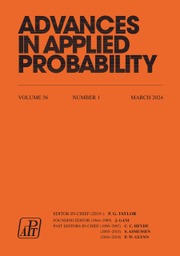No CrossRef data available.
Article contents
Uniqueness of locally stable Gibbs point processes via spatial birth–death dynamics
Published online by Cambridge University Press: 09 October 2025
Abstract
We prove that for every locally stable and tempered pair potential  $\phi$ with bounded range, there exists a unique infinite-volume Gibbs point process on
$\phi$ with bounded range, there exists a unique infinite-volume Gibbs point process on  $\mathbb{R}^{d}$ for every activity
$\mathbb{R}^{d}$ for every activity  $\lambda < ({e}^{L} \hat{C}_{\phi})^{-1}$, where L is the local stability constant and
$\lambda < ({e}^{L} \hat{C}_{\phi})^{-1}$, where L is the local stability constant and  $\hat{C}_{\phi} \,:\!=\, \sup_{x \in \mathbb{R}^{d}} \int_{\mathbb{R}^{d}} 1 - {e}^{-\left\lvert \phi(x, y) \right\rvert} \mathrm{d} y$ is the (weak) temperedness constant. Our result extends the uniqueness regime that is given by the classical Ruelle–Penrose bound by a factor of at least
$\hat{C}_{\phi} \,:\!=\, \sup_{x \in \mathbb{R}^{d}} \int_{\mathbb{R}^{d}} 1 - {e}^{-\left\lvert \phi(x, y) \right\rvert} \mathrm{d} y$ is the (weak) temperedness constant. Our result extends the uniqueness regime that is given by the classical Ruelle–Penrose bound by a factor of at least  ${e}$, where the improvements become larger as the negative parts of the potential become more prominent (i.e. for attractive interactions at low temperature). Our technique is based on the approach of Dyer et al. (2004 Random Structures & Algorithms 24, 461–479): We show that for any bounded region and any boundary condition, we can construct a Markov process (in our case spatial birth–death dynamics) that converges rapidly to the finite-volume Gibbs point process while the effects of the boundary condition propagate sufficiently slowly. As a result, we obtain a spatial mixing property that implies uniqueness of the infinite-volume Gibbs measure.
${e}$, where the improvements become larger as the negative parts of the potential become more prominent (i.e. for attractive interactions at low temperature). Our technique is based on the approach of Dyer et al. (2004 Random Structures & Algorithms 24, 461–479): We show that for any bounded region and any boundary condition, we can construct a Markov process (in our case spatial birth–death dynamics) that converges rapidly to the finite-volume Gibbs point process while the effects of the boundary condition propagate sufficiently slowly. As a result, we obtain a spatial mixing property that implies uniqueness of the infinite-volume Gibbs measure.
Keywords
MSC classification
Information
- Type
- Original Article
- Information
- Copyright
- © The Author(s), 2025. Published by Cambridge University Press on behalf of Applied Probability Trust


